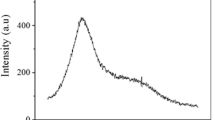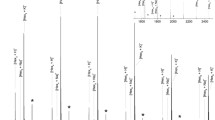Abstract
Proper identification and differentiation of natural polysaccharides is a very crucial task owing to some similarities in their appearance and properties. This research presents an extensive use of FTIR, a well-established and authenticated tool, for identifying and differentiating different classes of gums. Commercially important natural gums including plant exudate gums, seed gums, seaweed gums, microbial gums and animal gums were chosen for the study. For plant exudate gums, a peak at 1424 cm− 1 is common to all, which is absent in other classes of gums. A shoulder peak at 1728 cm− 1 and an ester group vibration peak at 1075 cm− 1 make gum karaya different from other gums. Peaks at 1647 cm− 1 and 1384 cm− 1, common to all seed gums, are absent in other gums and help to set identifying criteria for seed gums. In microbial gums, xanthan and gellan have no peaks in the range of 755–775 cm− 1, unlike other gums. In the case of animal gums (chitosan and gelatin) an intense sharp peak at 1636 cm− 1 is attributed to CONH2 group. Similarly, the paper explains characteristic peaks for gellan, carrageenan, agar, sodium alginate and other gums. Along with the in-depth discussion of major gum’s FTIR, this paper also endorses FTIR as a potential technique for identifying and differentiating natural gums.





Similar content being viewed by others
Data Availability
Data will be made available on request.
References
Nasrollahzadeh M, Sajjadi M, Iravani S, Varma RS (2021) Starch, cellulose, pectin, gum, alginate, chitin and chitosan derived (nano)materials for sustainable water treatment: a review. Carbohydr Polym 251:116986
Izydorczyk M, Cui SW, Wang physical properties Q (2005) Polysaccharide gums: structures, functional properties, and applications. Food carbohydrates Chem Appl 293:299
Thombare N, Srivastava S, Chowdhury AR (2014) Multipurpose applications of tamarind seed and kernel powder.Sci. Report.32–33
Prasad N, Thombare N, Sharma SC, Kumar S (2022) Recent development in the medical and industrial applications of gum karaya: a review.Polym Bull1–23
Prasad N, Thombare N, Sharma SC, Kumar S (2022) Production, processing, properties and applications of karaya (Sterculia species) gum. Ind Crops Prod 177:114467
Mishra S, Thombare N, Ali M, Swami S (2018) Applications of Biopolymeric Gels in Agricultural Sector. Polymer gels. Springer, Singapore, pp 185–228
Srivastava S, Chowdhury AR, Thombare N (2016) Quality Requirement and Standards for Natural Resins and Gums. Int J Bioresour Sci 3:89–94
Vickers NJ (2017) Animal communication: when i’m calling you, will you answer too? Curr Biol 27:R713–R715
Samborska K, Wiktor A, Jedlińska A et al (2019) Development and characterization of physical properties of honey-rich powder. Food Bioprod Process 115:78–86
Oniszczuk A, Wójtowicz A, Oniszczuk T et al (2020) Opuntia fruits as food enriching ingredient, the first step towards new functional food products. Molecules 25:1–11
Liu X, Renard CMGC, Bureau S, Le Bourvellec C (2021) Revisiting the contribution of ATR-FTIR spectroscopy to characterize plant cell wall polysaccharides. Carbohydr Polym 262:117935
Combrzyński M, Matwijczuk A, Wójtowicz A et al (2020) Potato starch utilization in Ecological Loose-Fill packaging materials—sustainability and characterization. Mater (Basel) 13:1390
Černá M, Barros AS, Nunes A et al (2003) Use of FT-IR spectroscopy as a tool for the analysis of polysaccharide food additives. Carbohydr Polym 51:383–389
Combrzyński M, Oniszczuk T, Kupryaniuk K et al (2021) Physical properties, spectroscopic, microscopic, x-ray, and chemometric analysis of starch films enriched with selected functional additives. Mater (Basel) 14:2673
Boulet JC, Williams P, Doco T (2007) A Fourier transform infrared spectroscopy study of wine polysaccharides. Carbohydr Polym 69:79–85
Caputo HE, Straub JE, Grinstaff MW (2019) Design, synthesis, and biomedical applications of synthetic sulphated polysaccharides. Chem Soc Rev 48:2338–2365
Nehdi IA, Sbihi H, Tan CP et al (2012) Characteristics, composition and thermal stability of Acacia senegal (L.) Willd. Seed oil. Ind Crop Prod 36:54–58
Postulkova H, Chamradova I, Pavlinak D et al (2017) Study of effects and conditions on the solubility of natural polysaccharide gum karaya. Food Hydrocoll 67:148–156
Li G, Ling M, Ye Y et al (2015) Acacia Senegal–inspired bifunctional binder for longevity of lithium–sulfur batteries. Adv Energy Mater 5:1500878
Sudhamani SR, Prasad MS, Sankar KU (2003) DSC and FTIR studies on gellan and polyvinyl alcohol (PVA) blend films. Food Hydrocoll 17:245–250
Lii C-Y, Liaw SC, Lai V-F, Tomasik P (2002) Xanthan gum–gelatin complexes. Eur Polym J 38:1377–1381
Sethi S, Kaith BS, Kaur M et al (2020) Cross-linked xanthan gum–starch hydrogels as promising materials for controlled drug delivery. 27:4565–4589
Vijan V, Kaity S, Biswas S et al (2012) Microwave assisted synthesis and characterization of acrylamide grafted gellan, application in drug delivery. Carbohydr Polym 90:496–506
Silva-Correia J, Oliveira JM, Caridade SG et al (2011) Gellan gum‐based hydrogels for intervertebral disc tissue‐engineering applications. J tissue Eng Med Regen 5:e97–e107
Brunchi C-E, Bercea M, Morariu S, Avadanei M (2016) Investigations on the interactions between xanthan gum and poly (vinyl alcohol) in solid state and aqueous solutions. Eur Polym J 84:161–172
Shalviri A, Liu Q, Abdekhodaie MJ, Wu XY (2010) Novel modified starch–xanthan gum hydrogels for controlled drug delivery: synthesis and characterization. Carbohydr Polym 79:898–907
Thombare N, Mishra S, Shinde R et al (2021) Guar gum based hydrogel as controlled micronutrient delivery system: mechanism and kinetics of boron release for agricultural applications. Biopolymers 112:e23418
Maiti S, Dey P, Banik A et al (2010) Tailoring of locust bean gum and development of hydrogel beads for controlled oral delivery of glipizide. Drug Deliv 17:288–300
Kaity S, Ghosh A (2013) Carboxymethylation of locust bean gum: application in interpenetrating polymer network microspheres for controlled drug delivery. Ind Res Eng Chem 52:10033–10045
Nayak AK, Pal D, Santra K (2014) Tamarind seed polysaccharide–gellan mucoadhesive beads for controlled release of metformin HCl. Carbohydr Polym 103:154–163
Dodi G, Hritcu D, Popa MI (2011) Carboxymethylation of guar gum: synthesis and characterization. Cellul Chem Technol Cellul Chem Technol 45:3–4
Hong T, Yin JY, Nie SP, **e MY (2021) Applications of infrared spectroscopy in polysaccharide structural analysis: Progress, challenge and perspective. Food Chem X 12:100168
Guerrero P, Etxabide A, Leceta I et al (2014) Extraction of agar from Gelidium sesquipedale (Rodhopyta) and surface characterization of agar based films. Carbohydr Polym 99:491–498
Pereira L, Sousa A, Coelho H et al (2003) Use of FTIR, FT-Raman and 13 C-NMR spectroscopy for identification of some seaweed phycocolloids. Biomol Eng 20:223–228
Gómez-Ordóñez E, Rupérez P (2011) FTIR-ATR spectroscopy as a tool for polysaccharide identification in edible brown and red seaweeds. Food Hydrocoll 25:1514–1520
Pereira L, Sousa A, Coelho H et al (2003) Use of FTIR, FT-Raman and 13 C-NMR spectroscopy for identification of some seaweed phycocolloids. 20:223–228
Carson L, Kelly-Brown C, Stewart M et al (2009) Synthesis and characterization of chitosan–carbon nanotube composites. Mater Lett 63:617–620
Tengroth C, Gasslander U, Andersson FO, Jacobsson SP (2008) Cross-linking of gelatin capsules with Formaldehyde and other Aldehydes: an FTIR Spectroscopy Study. Pharm Dev Technol 10:405–412
Acknowledgements
The authors acknowledge the Indian Council of Agricultural Research, New Delhi, for financial assistance and the Director, ICAR – National Institute of Secondary Agriculture (Formerly Indian Institute of Natural Resins and Gums), for guidance and support. The authors also thank The Dabur India Limited, Alwar, Rajasthan, and The AK Products Pvt. Ltd., Bilaspur, Chhattisgarh, for providing the gum samples.
Author information
Authors and Affiliations
Contributions
NT: Conceptualization, writing, analysis & editing; AM: Writing - original draft, experimentation & analysis; DS: Experimentation; ARC: Editing; MFA: Editing.
Corresponding author
Ethics declarations
Declaration of Competing Interest
The authors declare that they have no known competing financial interests or personal relationships that could have appeared to influence the work reported in this paper.
Competing Interests
The authors declare no competing interests.
Additional information
Publisher’s Note
Springer Nature remains neutral with regard to jurisdictional claims in published maps and institutional affiliations.
Electronic Supplementary Material
Below is the link to the electronic supplementary material.
Rights and permissions
Springer Nature or its licensor (e.g. a society or other partner) holds exclusive rights to this article under a publishing agreement with the author(s) or other rightsholder(s); author self-archiving of the accepted manuscript version of this article is solely governed by the terms of such publishing agreement and applicable law.
About this article
Cite this article
Thombare, N., Mahto, A., Singh, D. et al. Comparative FTIR Characterization of Various Natural Gums: A Criterion for Their Identification. J Polym Environ 31, 3372–3380 (2023). https://doi.org/10.1007/s10924-023-02821-1
Accepted:
Published:
Issue Date:
DOI: https://doi.org/10.1007/s10924-023-02821-1




